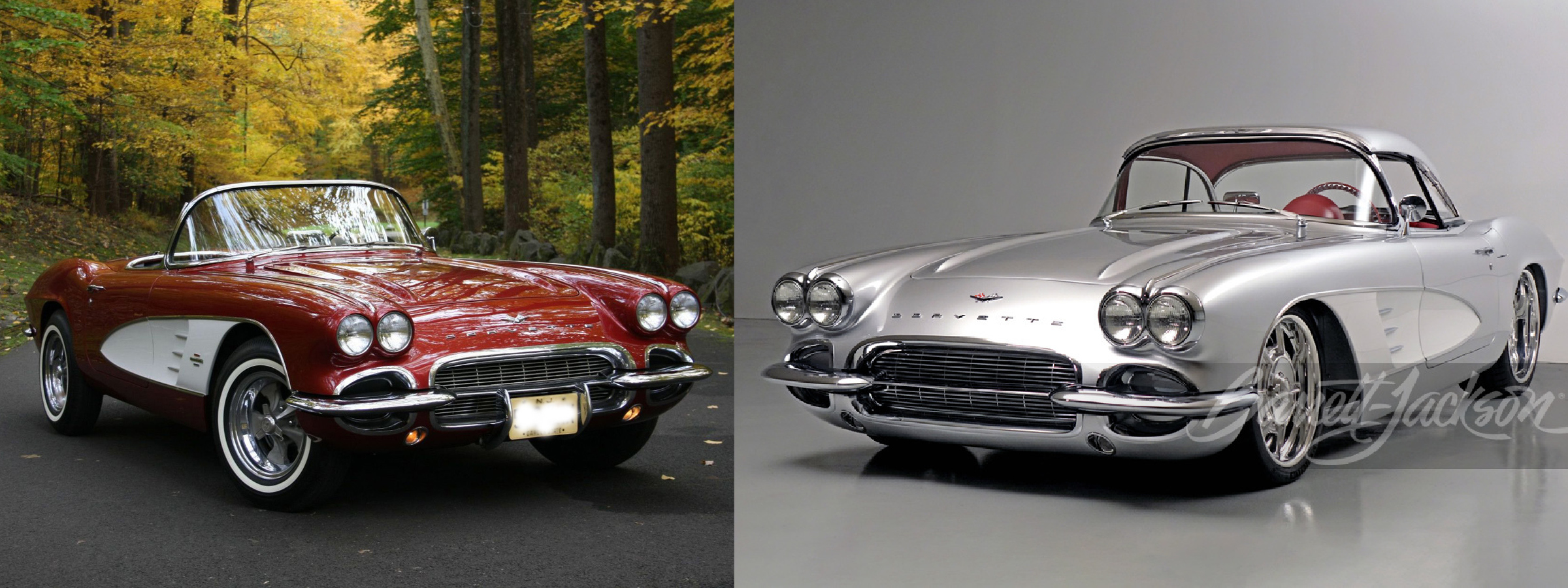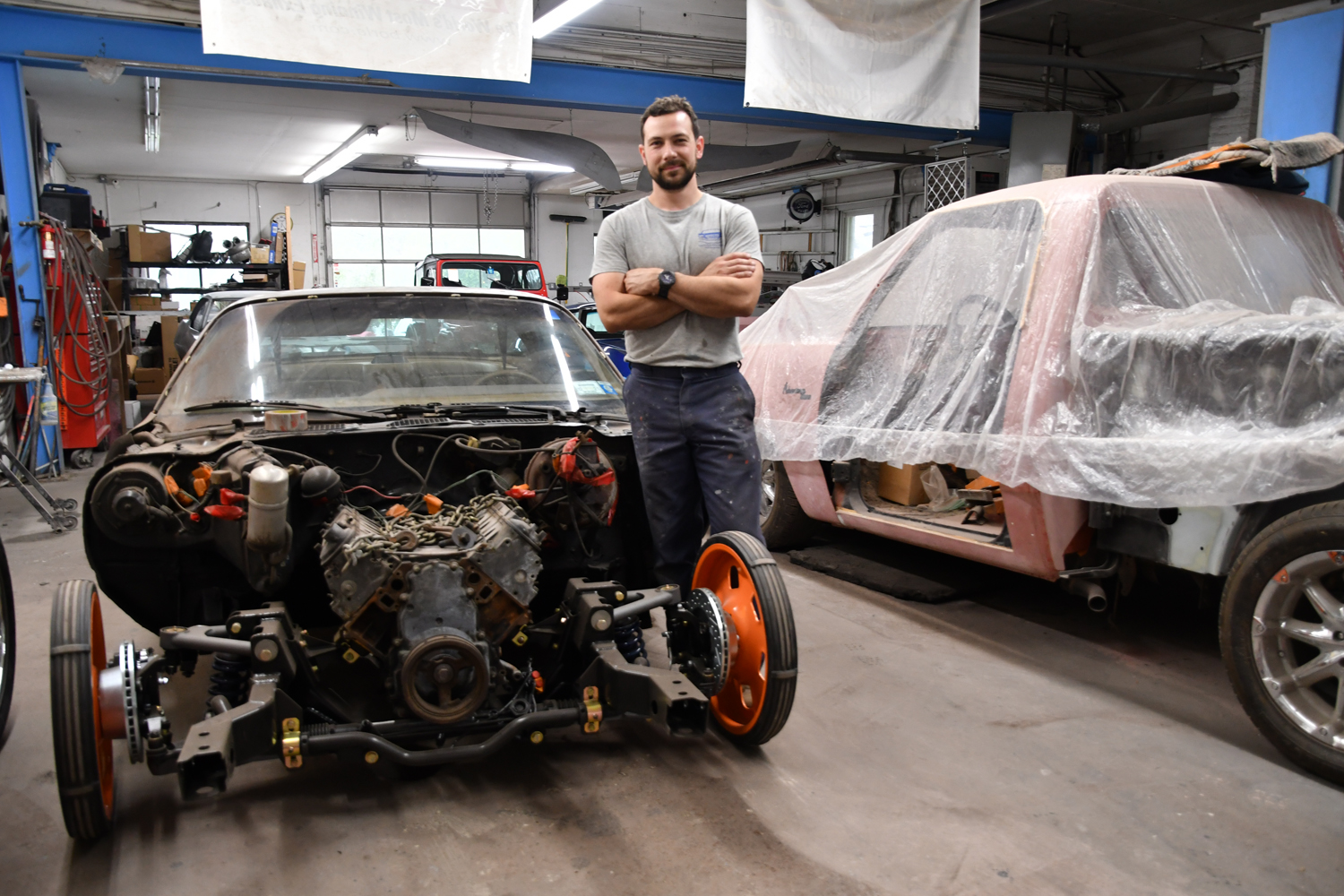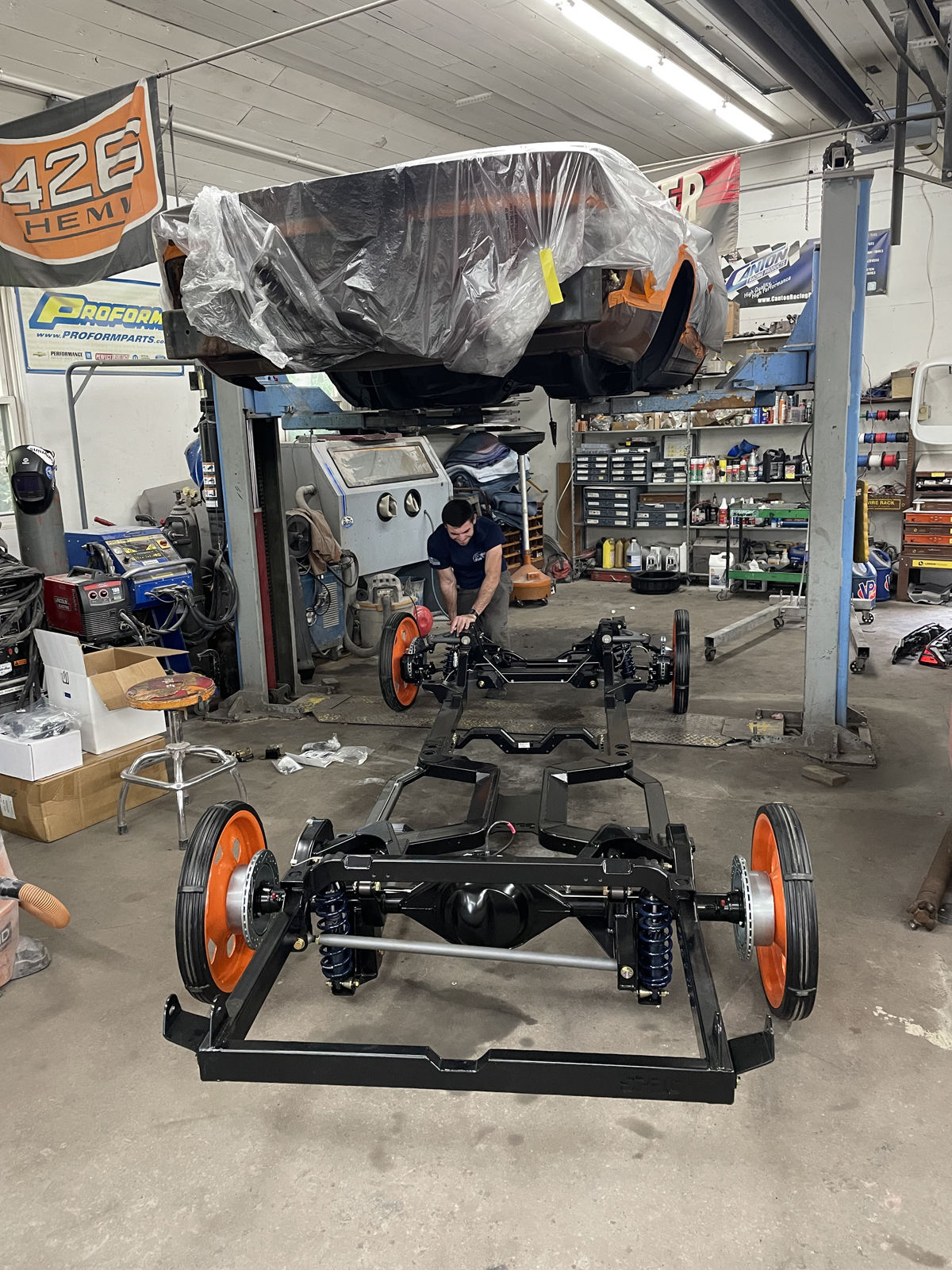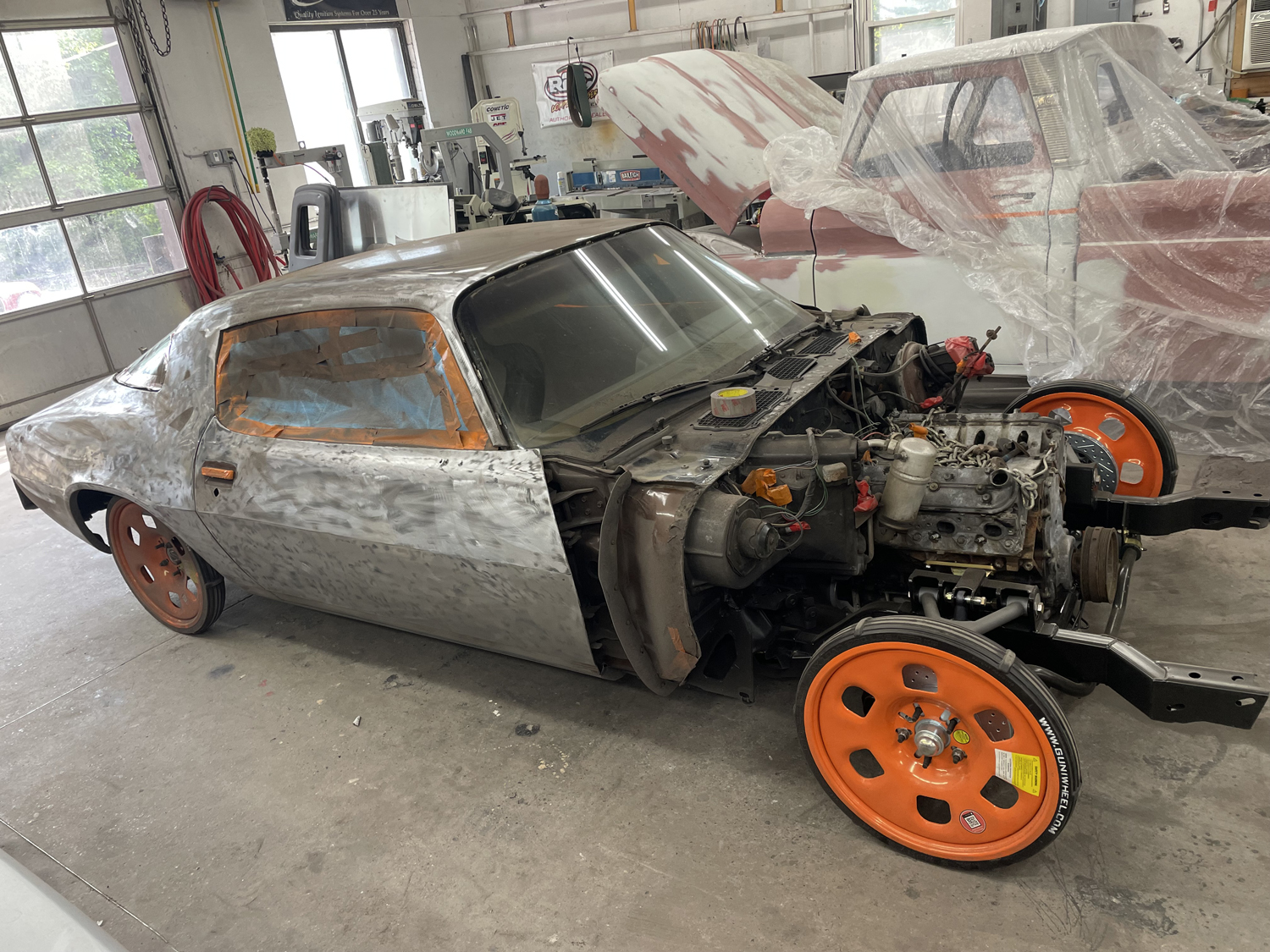Among classic car enthusiasts, the time was when referring to a specific vintage automobile as “original” was synonymous with the most valuable version. Today, that no longer can be assumed as a given.
Welcome to the ascendant age of the “Restomod.”
Restomods – Does original matter anymore?

1961 Corvette original $85K-$95K 1961 Corvette Restomod $467K
Clean, numbers matching muscle cars and Corvettes are no longer a given as the most prized examples on the auction block? That’s crazy talk. In years past, yes. Today, not so much. For those who have not noticed, recent times have witnessed a profound sea change in the vintage vehicle attributes that translate into the big dollars when crossing the block at auctions like Mecum and Barrett-Jackson. Restomods have supplanted numbers matching and very clean originals as stars on the auction stage.
Restomods are best described as domestic and import cars that retain their original classic look, but have been restored, modified and upgraded with the latest technology, power trains and chassis. Period correct technology like carburetors, distributors and dated suspensions have no appeal to the restomod buyer. Restomod buyers love the classic look but want the handling and performance technology bristling with modern capabilities.
Watching restomods’ startling rise to pinnacle status reflects not only a revolution in tastes, buyer demographics and perceptions of value but an even more fundamental change seen rippling through the very heart of the restoration industry. What can only be described as a tectonic shift is transforming the character of the builder community itself.

Jeff Buchak
To better understand the buyer and builder in the brave new world of restomod ascendance Drivin’ News reached out to restomod builder, Jeff Buchak, owner of Paradigm Auto Restorations and Matt Maisano owner of Motorcar Manor and a classic car purchasing consultant.
Matt starts off by noting that the car market in general took off around 2013 as the economy picked up. He says, “2013 is when we started seeing cars selling for what we thought, then, were ridiculous prices.” Matt points out that during that same period restomods started selling for descent money. That said, Matt makes the point that even five or six years ago at a Barrett-Jackson auction a restomod would sell for significantly less than an original version of the same vehicle. Matt gives an example saying, “Five or six years ago a standard 1967 big block Corvette would sell in the area of $160,000 while a restomod of the same model in similar condition would go for $125,000.” Matt continues to explain that today that same big block Corvette might go for $200,000 to $250,000 but a restomod based on a lesser 327 version might go for $375,000. When asked when did this big turnaround happen Matt points to 2017.
In reflecting on the restomod buyer Matt says, “A lot of people in the under 50-year demographic want to take it easy. Maybe they are a bit more lazy when it comes to driving and don’t want to deal with tune-ups and tweaking. These new restomod aficionados, unlike the traditional older car enthusiast, may not view the “joy” of maintaining a classic car as part of the fun.” Matt also notes the younger generations prevailing need for instant gratification. He or she wants the car to use, NOW, not after having to fiddle with a carburetor or such.
Are restomods a passing phase? Not in the opinion of Matt. He says, “Restomods are here to stay.” Interestingly he sees restomods becoming more desirable because they will be worth more and will hold their value. He says in the old school world none of this makes sense, but it’s a new world.” Matt gives the example of a standard 1966 327 Chevelle, not a Super Sport, that is all original including paint. He says, “That may be a $70,000 car based on its originality.” If you restomod that car it can become a $200,000 even a $300,000 car.

What then goes into making a restomod that so significantly increases the value of the base vehicle. For that we spoke with restoration shop owner, Jeff Buchak. Jeff has done a number of restomods and is presently starting on a 1979 Camaro with a 1970 Corvette waiting next in line.Jeff makes the interesting observation that around the early turn of the century, 2003 to 2004, the stock restoration of muscle cars reached its peak as enthusiasts became heavily invested in restoring these cars to their original form. However, Jeff notes that after pulling out of the Great Recession around 2012 people displayed an interest in exploring a different style of collector car. Jeff says, “Lots of new advanced technology came on the market creating a fertile environment to create a new class of collector car for people who liked the classic car look but loved the drive qualities of the latest performance technology.”
Seminal work on the restomod concept originated with the builders who had been focusing on “restoration to original condition” projects. Up until The Great Recession, 2008, restoration shops witnessed the hot market for restored muscle cars and thrived on the work. However, Jeff notes, “Builders saw that their beautifully restored classic cars, by contemporary standards, often drove horribly because of the authentic but dated technology.” According to Jeff, builders started exploring answers to the question, is there a better way?
Builders found the answer in the hybrid build combining classic car looks and contemporary performance technology. Then the tumbling dominoes of interest started to pick up speed. First builders created these classic cars with contemporary underpinnings for themselves. It then did not take long for collectors to notice and decide this combination of an old look and modern drivability was pretty cool. At that point collectors started pressing builders to create these restored and modified (resto-mod) creations for the collector himself. Jeff says, “Then it just started to accelerate.” From around 2012 to 2017 a lot of engineering and development trial and error took place. By 2017 the restomod build had been sorted out and blossomed into a full blown and accepted and increasingly prominent new class of collector vehicle. The question then asks what accepted solutions had been distilled during the sorting out process that made the restomod so successful as a new category of collectible car.
BODY

A solid clean body means everything. A good body saves an immense amount of money. Jeff says, “It is conceivable that you could save $30,000 to $40,000 with a nice body that needs minimal body work and rust repair.” In the case of Jeff’s ’79 Camaro project the body, from out west is solid with minimal needs.
For the ’70 Corvette Jeff will do next, the whole car is an original one-owner car. Basically the customer paid $35,000 to get a great body and good VIN#. He said they made money selling the motor, drivetrain and chassis. Being a solid body they saved thousands on unnecessary fiberglass work.
An interesting sidebar to the importance of a solid body is the growing market for a clean title and VIN # that matches the car from which a restomod will be created. Jeff says, “People are paying crazy money for a title because as long as you have a title and VIN# you can build anything.” With a good VIN# you can call up Auto Direct and order a full Camaro body or Tom’s Bronco in California for a Bronco body. Jeff has seen people pay eight to ten thousand dollars on a car just to get the VIN plate.
CHASSIS
For his ’79 Camaro project Jeff is using a Roadster Shop brand chassis. Jeff says, “It is a great product and a smart way to control costs instead of custom fabricating a chassis.” On Jeff’s end, the client avoids a significant custom labor cost. Jeff says, “I’m going to call up Roadster Shop. I’m going to order a roadster shop chassis specific to the ’79 Camaro. It comes already set with the proper motor and transmission mounts.”
Before ordering the chassis it is critical to explore what the client wants because the chassis will come completed to match his specs. Is the intention to race or drive it on the street? Important questions include the stance desired, type of suspension and braking.
Costs can add up quickly. Jeff says, “If the customer intends to be road racing and wants an independent rear suspension, that is Ten thousand dollar upgrade. If you want a billet aluminum CNC-machine center section, Throw another 5,000 on. Eye candy options abound. For a 68 to 72 C3 Corvette, you can get a really great driving powder-coated chassis delivered to your door for twenty seven to thirty thousand dollars. You can get it with an independent rear suspension, Billet CNC’d Center section, all the works, huge brakes. And it’s an additional twenty to twenty five thousand dollars.
ENGINE
Jeff notes that, in most cases, for engine choices there exist three options. The Hemi crate motor from Chrysler performance comes as the 5.7-liter, 6.4-liter or Hellcat motor. Its guaranteed from 400 to 1,000 horsepower.
Secondly, You can call up Ford performance and order a 5-liter coyote motor out of the Mustang.
Then there are the GM LS Motors. Jeff says, “The LS motors are probably the most desirable because of their potential. The aftermarket is endless. So many different manufacturers make every single product. I like Texas Speed and Performance. They have a really nice formula showing how to achieve different stages of power. They can guide you.”
TRANSMISSION
Choice of transmissions almost exclusively centers on 6–speed Tremecs as compared to 5-speeds and automatics. Part of the allure comes with the reality that very few new performance cars even come with a manual transmission available.
BRAKES
Jeff says, “For a strictly street use application roughly $1100 dollars can get you 11 inch or 12 inch rotors and 4-piston calipers front and back from Baer. If you’re going to be constantly pounding the brakes doing a pro touring circuit track, then you’re going to go to a 14-inch ceramic-coated rotor and a 6-piston caliper from a new Z06 and that brake package is around ten thousand dollars.”
UPHOLSTERY AND PAINT
As the saying goes “it’s a matter of taste.” Purely customer choice, an interior can be the focal point of a restomod or a purely functional treatment.
So too with paint. Jeff’s true art and passion resides in his commitment to perfect paint. The idea of an “OK” paint job on a one-off restomod passes well beyond the line of bad choice to crazy. In Jeff’s mind, a bare restomod body offers a blank canvas crying out for an artist.
1979 CAMARO PROJECT
In the future, Drivin’ News intends to revisit Jeff’s completed ’79 Camaro restomod. For now the plan calls for a Roadster Shop chassis, 525 horsepower LS engine, 6-speed Tremec T56, 20-inch aluminum snowflake wheels from Forgeline painted gold polish finish that recalls the original Camaro wheel and a custom brown paint.
An interesting and final thought brought to mind by Jeff questions the future of auto restoration. Jeff says, “Eventually I believe most auto restoration will fade out. Restoration will be replaced by the building of individual cars utilizing superior contemporary technology.”
Jeff sees that, today, people really are not restoring vehicles to factory spec unless they have a lot of value.
Jeff believes the future will see people starting with a classic shell and contracting with a shop to build it to their specifications.
He thinks that a few cars worth a lot of money will continue to be the subject of a restoration but there are not that many original vehicles left to be restored like that.
Jeff says, “How many original un-restored L88 Corvettes are there left to restore?. I mean there’s a lot of regular 64 Corvettes that just came with 327s. But even now these are the cars that people are using as the basis for a restomod.
Jeff believes they are doing the right thing. Do you?

I guess I would have to agree with just about everything Jeff and Matt had to say about the increasing desirability of restomods! People in their 40s and 50s appreciate the distinctive appearance of cars designed during the second half of the last century, but when they go to drive it, they expect it to drive like “a real car”. Our expectations for powerful braking, responsive steering, and great acceleration are hard to find in older cars.
If I had to bet on what the next change in restomods would, I would guess it would be a move from 6-speed manual gearboxes to automatics. We are rapidly reaching an era where new drivers just never have the opportunity learn to drive a manual transmission car.
I guess that is progress! Why try to fight it…
Yours appears to be an accurate observation and a high probability vision of the future.